by Dorota Popławska
Abstract
translated by Aleksandra Rodzińska-Chojnowska
The oldest stone depictions of musical instruments in Lower Silesia date from the thirteenth century. The figures of music-making angels or laymen are, however, among the rarest Gothic stone sculptures in the region. Pertinent research discovered only about thirty such depictions portraying fifteen types of instruments. The musical instruments appear in sculpted iconography primarily in scenes of the Last Judgment. Initially, these scenes included assorted wind instruments which at the end of the fifteenth century were also accompanied by string and percussion instruments. Other Biblical scenes predominantly show various types of string instruments. Instruments sculpted in sandstone or marble were placed on tympana, corbels, keystones and epitaphs, and at the end of the fifteenth century, musical instruments were present also in genre scenes decorating the Town Hall in Wrocław. A characteristic feature of the objects in question is the realistic rendering of the appearance of particular instruments and the techniques of performance. Stone sculpture is an essential and heretofore totally ignored source for becoming familiar with the medieval music instrumentarium of the region. The presented study is the first to examine this topic.
Article
translated by Maria Anna Harley
The iconography of musical instruments from the Gothic and the early Renaissance periods is closely connected with the usage of figurative sculpture in architectural contexts. [1] Until the beginning of the 16th cenury the figures of angels and secular persons making music are among the least frequent motives of stone sculpture in the area of Lower Silesia.[2] My research has resulted in finding only thirty such representations, while the catalogues of figurative stone sculpture used in architectural contexts contain scores of items.
The sculptures with representations of musical instruments that I have found are linked to architectural details and epitaphs that are located in Silesian churches and in the Wrocław City Hall [Ratusz]. In the analyzed material there are no free-standing stone sculptures that would contain motives of interest for this project. Despite the limited number (30 items) the stone sculpture is an important, but hitherto not drawn upon, source of information about musical instruments used in Lower Silesia. In this paper, I will present the first classification and description of the majority of these representations. Some of these items have not yet been reproduced in the scholarly literature on the subject.

The oldest representations of musical instruments in Lower Silesia, carved in sandstone, may be found in the Cistercian convent in Trzebnica (the province of Wrocław).[3] The instruments are located at the tympanon of the western portal.[4] In this scene (completed in the years 1230-1240) portraying King David with Queen Betsheba, the King plays a North-European lyre (see Fig. 1).[5] This instrument, initially painted black, has a large body with two arms extending from it. [6] On the soundboard, besides two sound holes cut in the shape of the letter “D” and placed symmetrically against each other, there is a tailpiece for the strings built from two ear-shapes connected with a cylindrical block. King David plucks the strings with his right hand, while the left hand touches the lyre across the sound hole (on the bottom side).
The Trzebnica tympanon, an excellent exemplar of Central European art, is the only known late-Romanesque stone sculpture from Lower Silesia that includes a musical instrument. During the Gothic period, at the end of the 13th century, the stone iconography in Lower Silesia begins to include wind instruments. Such instruments may be found on the shields of the keystones located at the ribs of the ceiling in the main nave of the post-Joannite church dedicated to the Blessed Virgin Mary in Złotoryja. These representations, carved in sandstone ca. 1293, [7] belong to the cycle of images from the Last Judgement. The central figure here is Jesus Christ, surrounded by angels holding musical instruments or inscriptions.
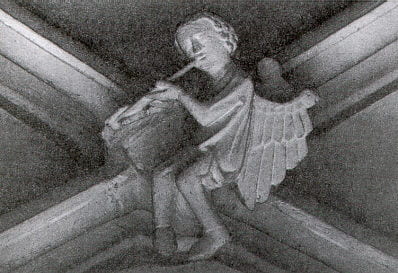
The angels call to judgement human figures which emerge from their coffins. Among several instruments that were initially placed on the keystones in the Złotoryja church[8] only one has been preserved intact. (see Fig. 2). This instrument is, most likely, a curved horn, so-called “black” horn [cynk czarny] with an arched form and, probably, a circular cross-section.[9] The angel holds the instrument in the corner of his mouth, supporting the instrument’s body with the left hand placed near the bell.Stone representations of musical instruments in the church in Lubań Śląski (presently an Evangelican Church) date back to the second half of the 14th century. This church has very rich sculptural decorations; among the many architectural sculptures carved in sandstone there are several images of string instruments. These instruments are located at the supporting cantilever under the polygonal profiles in the presbytery. One of the instruments highlighted there is a gittern – a kind of a small, medieval lute (see Fig. 3).[10] In the pegbox of this instrument there are eight pegs, inserted from the sides. The fingers of the left hand press, and those of the right hand pluck, the invisible strings. The body of the instrument rests on the right arm of the musician.
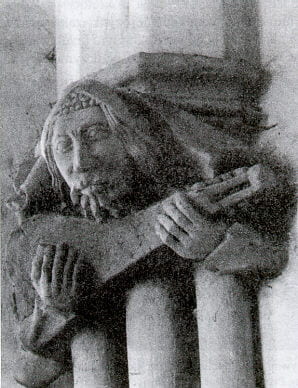
The second chordophone is a bowed medieval fiddle. This instrument has three strings placed above the soundboard which has a carved resonance hole. The instrument’s body ends with a narrow neck and an oval pegboard on which four vertically-inserted pegs are located. The strings of the fiddle are incited with the bow; its stick and hair parts are clearly visible. The fingers of the left hand of the performer press strings at a level that indicates the use of the first position (see Fig. 4).[11]

The end of the 14th century brings more representations of string and wind instruments. Their images are carved in sandstone on the western portal of the stone church dedicated to Saints Peter and Paul; this church is located in Strzegom.[12] In a scene portraying the legend about the conversion of St. Paul, a rider seated on a horse holds a short horn (a probable identification) with a widening bell[13] (see Fig. 5). Next to the rider there is an angel playing on a string instrument which is, most likely, a medieval fiddle.
Images of musical instruments occur with greater frequency in the religious stone art in the 15th century and at the beginning of the 16th century than in the earlier times. On a keystone, shaped like a shield with an emblem, and located in the filial church dedicated to saints Anthony and Maciej in Glinica (built ca. 1500), there are two representations of short, curved horns, with clearly visible bells[14] (see Fig. 6).
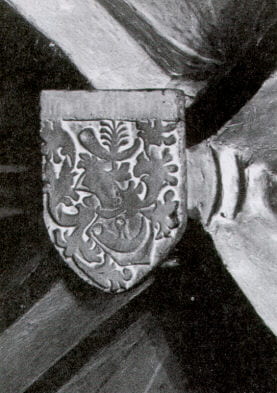
Other types of instruments may be found, for instance, on epitaph tablets, the scenes in which these instruments are portrayed, usually belong to the cycle of The Last Judgement. One of such epitaph tablets is located in the church of St. Magdalene in Wrocław. Made from black marble in 1496, the tablet was dedicated to Wrocław burghers, the parents of Andres Fogeler.[15] There are two horns carved on this tablet: the first one is straight, short, with a clearly outlined bell, the second one is of a similar size, but it is slightly curved. Two angels blow into these instruments; the angels lean out from behind swirling clouds that surround Christ. The angels support their horns with both hands, holding the instruments in the middle (see Fig. 7).
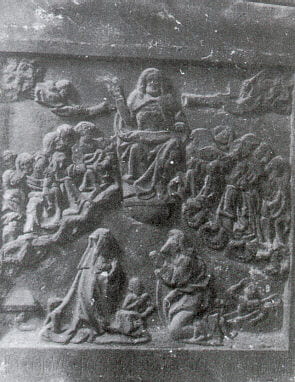
The next two epitaphs with musical instruments come from the Church of St. Elizabeth in Wrocław. The epitaph of the Krapp family, carved in sandstone, has been approximately dated to around the turn of the 16th century. The central part of this epitaph tablet features an angel blowing into a long, narrow, slightly curved trumpet; the angel is located between two groups of people placed below Christ. The trumpet that the angel plays widens only at the bell.[16]
The second epitaph with musical instruments, also from the Church of St. Elizabeth in Wrocław was made ca. 1505. It is dedicated to the family of Krzysztof Rintfleisch (see Fig. 8). On the left and the right side of God, the Father, conducting the Last Judgement, groups of angels stand, sing and play different varieties of musical instruments.[17] Here, wind instruments are represented by a curved horn, the membranophones are exemplified by a tambourine struck by hand, while the representations of string instruments include the Gothic harp and, most probably, a plucked psaltery. It is certain that these two stone epitaphs were carved by masons employed to decorate the Wrocław City Hall.
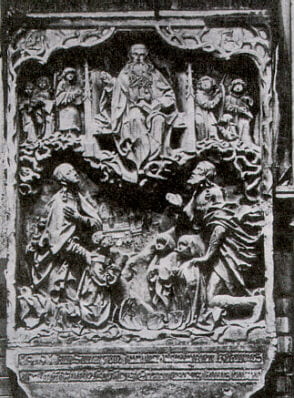
The Wrocław City Hall, completed at the turn of the 16th century, is the only preserved secular building in Lower Silesia with a facade decorated with, among other objects, stone figures of people playing musical instruments. [18] The representations discussed here were created in the years 1485-1490 and may be found on the southern wall of the City Hall. Several figures of musicians are incorporated into a fully carved decoration of two friezes above the first and the second floors of the building. These sculptures are grouped in scenes devoted to single subjects (e.g. in the market, in the inn, at the hunt).[19] The scenes are usually separated from each other with floral ornaments. Other figures making music support two bay windows in the southern wall: the central and the western ones. Each of the figures is placed below an angel; this juxtaposition of the inhabitants of heaven and earth is unusual in Gothic art. The decoration of the southern wall of the City Hall was produced in the workshop of Briccius Gauske from Zgorzelec, who probably designed it himself and who made some figurative details.[20]
A string instrument that appeared both in religious and in secular iconography is the fiddle. It may be found in the lower frieze of the southern wall of the Wrocław City Hall.[21] The pear-shaped body of the instrument is extended with a narrow neck (see Fig. 9). The man who plays on this instrument is seated beside a huge vase and presses the strings with the fingers of the left hand while holding the bow with the right hand. He is accompanied by a flautist who plays a one-handed pipe. The pipe’s embouchure hole and the lowest sound hole are clearly visible. Since the piper plays the instrument with one hand, it is not impossible that he uses the right hand (partly invisible) to play a drum or a tambourine.

Here, we probably encounter a juxtaposition of two instruments in the hands of one performer which is typical for musical practice of the Middle Ages. These two instruments are a one-handed pipe (in German: Schwegel) and a drum [i.e. the “pipe and tabor” ensemble – translator’s note]. It is certain, however, that these two instruments are shown together in another image from the City Hall frieze (see Fig. 10). Here a musician plays a one-handed pipe and a cylidrical drum, struck with a large-headed mallet; the musician walks before a wheel-barrow on which a drunk woman is being carted away.[22]
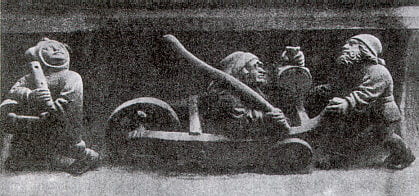
This representation is located at the upper frieze of the southern wall of the City Hall. In addition, there are two representations of hunting horns on this frieze. One of the horns is held by a hunter on horseback.[23] The performer touches the semicircular instrument to a corner of his mouth, not to the center of his lips. He holds the instruments in the palm of the left hand in such a way that instead of the thumb, four of the fingers are visible (see Fig. 11). It is a very uncomfortable position, forcing a strong twisting of the palm. The second horn, of the same form and size, is held by a hunter on foot. [24] The ways of blowing and holding the instrument are the same as described above. On the basis of these irregularities, I assume that the masons who carved these figures were not well schooled in the ways of playing the hunting horn.
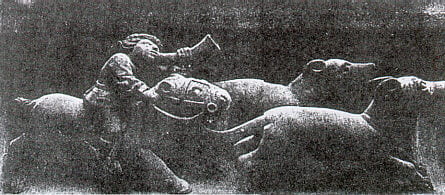
Figurative friezes which include scenes with musicians are also known from the house of Waga (1521) in Wrocław (this house was not preserved); these friezes have been incorporated into the decoration of the Wroław City Hall. One example includes a figure of a musician accompanying a round dance with music played on the one-handed pipe and on the small drum with clearly depicted ropes that hold the instrument’s membrane (see Fig. 12).[25]

On the southern facade of the Wrocław City Hall, below the figures of angels who support the central and the western bay windows, one may find, for instance, four stone sculptures of lay persons who play musical instruments. The central bay window is located at the entrance to the Świdnica Basement (Piwnica Śidnicka – an inn). These realistic sculptures depict its ribald clientele and, perhaps, faithfully render the atmosphere of the interior and the behaviour of the frequent customers of this establishment.

In this group of images four different musical instruments may be found. String instruments are represented by a trapezoid psaltery with its shorter sides cut in somewhat semi-circular outlines (see Fig. 13). [26]The psaltery has about fifteen strings. A sound hole with a decorative rosette is visible on the soundboard of the instrument. The remaining three figures of the musicians from the Wrocław City Hall are depicted as performing on wind instruments: the shawm, the bagpipes, and small bagpipes [siesieńki]. All of these instruments are reed instruments. The shawm from the Wrocław City Hall has a simple body consisting of one part, with a cylindrical cross-section (see Fig. 14). The sculpture depicts the lowest sound hole of the instrument. The left hand of the musician is located higher than the right hand while the fingers of the left hand cover the sound holes. [27]
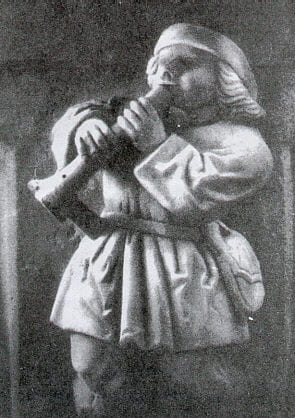
The small bagpipes consist of a large, leather bag (the container of air), of a pipe built into it and used for blowing the air inside (mouth pipe), as well as of two other pipes – a melodic pipe (chanter) and a drone pipe (see Fig. 15). Both of these pipes end with slightly widening bells.[28] The bagpipes player covers the holes in the melodic pipe with his fingers while the drone pipe rests on his left shoulder.

The next stone representation of a musical instrument from the Wrocław City Hall portrays a smaller type of the bagpipes [siesieńki], made from an animal bladder into which a mouth pipe and a melodic pipe are inserted.[29] The performer holds the mouth pipe in the corner of his mouth while pressing the bag with the left hand and covering the holes in the melodic pipe with the fingers of the right hand (see Fig. 16).

The final representation of a musical instrument to be discussed in this paper contains three slightly curved horns. [30] These horns are sculpted on the keystone shaped like an emblem shield in the Senior Hall of the Wrocław City Hall (see Fig. 17). These horns are crossed with a spear; the instruments are of equal length and have clearly profiled mouthpieces.

The representations of musical instruments in Lower Silesia, carved in sandstone or marble, may be found on tympani, keystones, cantilevers, and epitaph tablets. The characteristic feature of this collection of images is the realistic representation of both the individual instruments and the contemporaneous performance techniques (with the exception of the hunting horn from Ex. 11). The stone scuptures discussed above, depict an array of fifteen types of instruments. These types include: the North-European lyre [or, rather, kithara – translator’s note], fiddle, gittern, hunting horn, trumpet, bagpipes, small bagpipes, shawm, one-handed pipe, tabor, and cylindrical drum. As it may be seen from this list, the string instruments are represented both in their plucked and bowed varieties. The aerophones are exemplified by all the different types: lip-vibrated aerophones (brass instruments with mouthpieces), flutes, and reedpipes (shawms and bagpipes). Finally, the percussion instruments include only instances from the group of the membranophones.
Lip-vibrated aerophones are the most common subject for depiction. In the 15th century hunting horns occur both in the imagery from the Last Judgement and in hunting scenes. The so-called “black” horns, appearing in stone sculptures since the end of the 13th century also belong to this group. An image of a narrow-piped trumpet is also connected with the imagery of the Judgement Day. This type of instruments appears in the iconography in Lower Silesia as early as the middle of the 13th century. Several such images may be found in the Expositio in Apokalipsim by Aleksander Minoryta from ca. 1271. The images of trumpets and horns are also known from some ducal seals (e.g. those of Bolesław Rogatka from the year 1244, and of Bolesław the Third, 1304).[31]
In the stone iconography of Lower Silesia reed instruments are also a rich and varied group. The bagpipes, small bagpipes and the shawm appeared in the 15th century. These instruments are connected with secular music. A similar function can be ascribed to one-handed pipes which usually formed an ensemble with a cylindrical drum. Such one-handed pipes had been known in Lower Silesia since the 11th century. This fact is proven by archeological discoveries of several such instruments in the city of Opole.[32]
String instruments provide the remainder of the stone representations of musical objects. In this group, only the fiddle appeares three times. It was depicted both in the context of church music, and in the context of secular music. The representations of such instruments described above as the North-European lyre, trapezoid psaltery, and plucked psaltery are, in accordance with the current state of research, among the last examples found in the medieval art of Lower Silesia. In contrast, Gothic harps appear in this repertory of images only at the end of the 15th century.
The stone sculptures that I have discussed in this paper do not provide a full range of string instruments that are encountered in other types of images in the art and literature of Lower Silesia. We have not, for instance, found any lutes, which are known from the wood sculpture of the triptych from the Church dedicated to the Assumption of the Blessed Virgin Mary in Bąkowo (1370-1380)[33]. In contrast, the percussion and wind instruments are represented in the stone sculpture in greater numbers than in the remaining types of art. Moreover, in the analyzed material there are no portative organs known, for instance, from the triptych in Bąkowo or from the 15th-century Missale originating from the workshop of Mikołaj of Nysa.[34]
The analysis of the research material allows me to formulate the following conclusions:
- Stone iconography in Lower Silesia from the late Romanesque, Gothic and early Renaissance periods contains realistic portrayals of musical instruments and of the techniques of performance.
- The stone representations of musical instruments in Lower Silesia appearing from the beginning of the 13th century to the end of the 15th century, occur solely in church art. In the domain of secular art, stone iconography of musical instruments has emerged only at the end of the 15th century.
- The stone architectural sculpture of Lower Silesia includes all the types of music instruments known at the time: chordophones, aerophones, and percussion instruments. These groups are represented by fifteen varieties of instruments.
- The most common representations are of wind instruments. Among the winds, the largest group is of brass with mouthpieces. The stringed instruments are represented mostly by plucked chordophones, and the percussion instruments are exemplified by membranophones.
Notes
[1]. This article is an expanded version of a conference paper read at the International Congress “Rock Art” held at 30 August 6 September 1995 in Turin, Italy. My participation in the Congress was made possible by a grant from the Batory Foundation in Warsaw. The Polish text of the article, entitled “Przedstawienia instrumentów muzycznych w kamiennej rzeźbie na Dolnym Śląsku do pocztku XVI wieku” appeared in Muzyka vol. 42 no. 3 (1997), p. 79-97. English translation by Maria Anna Harley. The translator thanks Prof. Richard Wingell, Prof. James Tyler and Ms. Anne Desler for comments that helped improve the accuracy of the translation.[Back]
[2]. Initially (in the 12th century), stone sculpture in Poland consisted of floral or geometric ornaments. Figurative ornaments emerged universally at the end of the 13th century. However, already at the end of the 14th century, a cultural process began that led to a diminishing value of stone decorative sculpture for the sake of wood sculpture. The masons were left to carving tablets, epitaphs, door-frames, keystones, or modest entrance portals without any figures (but, frequently, with sophisticated outlines). See Juliusz Starzyński and Michał Walicki, Reźba architektoniczna w Polsce wieków średnich [Architectural Sculpture in Poland in the Middle Ages]. Warsaw 1931, p. 24ff.[Back]
[3]. This abbey, built by Master Jacob, was created thanks to the patronage of a prince from the Piast dynasty, Henryk Brodaty. [Back]
[4]. See Dagobert Frey, “Das romanische Tympanon des Westportals der Klosterkirche in Trebnitz” In Alfred Zinkler, Dagobert Frey, Günther Grundsman: Die Klosterkirche in Trebnitz. Breslau, 1940, p. 117-146. See also Jerzy Banach, Tematy muzyczne w plastyce polskiej [Musical subjects in Polish art], Kraków, 1956, vol. 1, fig. 2; Dorota Popławska, Średniowieczne instrumenty strunowe na ziemiach Polski, Czech i Rusi[Medieval String Instruments in the Lands of Poland, Bohemia, Rus], Warsaw, 1996, p. 8, fig. 1. [Back]
[5]. Institute of Fine Arts of the Polish Academy of Sciences (further cited as IS PAN) in Warsaw, no. of film 96777. I wish to offer my sincere thanks to Dr. Tadeusz Jurkowlaniec for allowing me to reproduce here seven photographs from the collection of the Department of Medieval Art IS PAN. [Authors’s note]
According to Prof. Richard Wingell this instrument may be identical with the Welsh “crwth” [e-mail correspondence with the translator]. Prof. James Tyler, however, states that the instrument sculpted here is modelled on the classical kithara, not a lyre [e-mail correspondence with the translator], “From the position of the player’s left hand, it seems that the instrument once had a central neck and fingerboard, as seen on representations from late antiquity to about the 10th century.” See also Emanuel Winternitz, Musical Instruments and their Symbolism in Western Art (London, Faber and Faber, 1967, Chapter 3 – “The Survival of the Kithara/Cittern”).[Back]
[6]. In the area of Lower Silesia another type of the lyre was also used at the time. The hole for the performer’s fingers was cut directly in the stringboard. Such instruments are known from archeological discoveries made in Opole. See Popławska, op.cit. p. 8, diagrams no. 1a and no. 11. [Back]
[7]. It is generally believed that the sculptures on keystones in Złotoryja were made by masons from the area of Marburg or Silesia. [Back]
[8]. On the basis of the position of the angels’ hands one could assume that these were wind instruments. See catalog cards in the Center for Documenting Monuments in Warsaw (Ośrodek Dokumentacji Zabytków, further cited as ODZ), no. LGX 000 003 903, LGX 000 003 904. [Back]
[9]. Card ODZ no. LGX 000 003 905; IS PAN in Warsaw, , film id. no. 6549. [Author’s note]According to Prof. Richard Wingell [e-mail correspondence with the translator], the horn resembles the instrument called “Zinckz” in German or the 16th century “cornetto.” This wind instrument has a cup mouthpiece like a trumpet and six holes like a woodwind. It is really a hunting horn (i.e. it is used for this purpose) and it will be called “hunting horn” in the remainder of the paper. [Translator’s note].[Back]
[10]. Card ODZ no. JGX 160 002 876; IS PAN , film id. no. 2631 [Author’s note]. Gittern is a small instrument, played with a plectrum and similar to a treble lute, but distinct from the contemporary lute. See James Tyler and Peter Sparks, The Early Mandolin (London, 1989, Chapter 1), [Translator’s note]. [Back]
[11]. Card ODZ no. JGX 190 002 876; IS PAN in Warsaw; , film id. no. 2630. [Back]
[12]. The Strzegom church was probably built by Master Jacob who had strong ties with Silesia. [Back]
[13]. It is not impossible that it is a representation of a sword. IS PANd , film id. no. 13669. [Back]
[14]. IS PAN, film id. no. 12697. [Back]
[15]. Card ODZ no. WRK 000 006 200.[Back]
[16]. Card ODZ no. WRX 000 005 939. [Back]
[17]. See Zygmunt Świechowski, ed., Wrocław, jego dzieje i kultura. [Wrocław: Its History and Culture] Warszawa, 1978, fig. 91. [Back]
[18]. This type of a façade with rich figurative decorations, where the walls are covered with carpet-like ornaments is exceptionally rare in Silesia. A certain similarity to the Wrocław City Hall may be found in the group of municipal buildings of the Netherlands and Holland from the 15th century. See Mieczysław Zlat, Ratusz Wrocławski [The Wrocław City Hall]. Wrocław: 1976, p. 90. [Back]
[19]. Certain scenes on these friezes have been copied from the work of a Dutch graphic artist called the “Master of the Home Book” (Zlat, p. 93). [Back]
[20]. Zlat, p. 28-29, 91. Friezes consisting of figurative motives and ornamental ribbons of leaves have an earlier counterpart in the façade of the Stone House in Kutna Hora. These carvings, similarly to the friezes of the Wrocław City Hall, are a work of B. Gauske, dating back to the years 1490-1493. [Back]
[21]. See Rudolf Stein, Der Scheidnitzer Keller im Rathaus zu Breslau. Breslau 1941, fig. 4. The artifacts were destroyed during the war; the current state was achieved as a result of their re-construction in 1950 (See Zlat, p. 88). [Back]
[22]. See E. Lüdecke, Rathaus zu Breslau. Erneuerunge – Arbeiten in den Jahren 1884-1891. Breslau, 1898, table 12; Ludwig Burgemeister, Das Breslauer Rathaus. Breslau, 1913, fig. on p. 44. [Back]
[23]. Lüdecke, op. cit., tab no. 13; Burgemeister, op. cit., p. 44. [Back]
[24]. Burgemeister, op. cit., p. 26. [Back]
[25]. IS PAN, film id. no. 37373. [Back]
[26]. Stein, op. cit., fig. 46. [Back]
[27]. Ibidem, fig. 47 [Author’s note]. According to Prof. James Tyler, the author’s identification of this instrument as a shawm is erroneous [e-mail correspondence with the translator]. The instrument should simply be called a “pipe” – this term, similarly to the “fiddle” and “horn” used above – is generic and not specific [Translator’s note]. [Back]
[28]. Ibidem, fig. 56. [Back]
[29]. Ibidem, fig. 57. [Back]
[30]. Ibidem, fig. 156. [Back]
[31]. See Świchowski, op. cit., fig. 91; Janusz Kłębowski, Nagrobki gotyckie na Śląsku [Gothic Tombstones in Silesia]. Poznań, 1969, fig. 17. [Back]
[32]. Włodzimierz Kamiński, Instrumenty muzyczne na ziemiach polskich. [Musical Instruments in Polish Lands]. Kraków, 1971, p. 42, fig. 33. [Back]
[33]. Heinz Braune, Erich Wiese, Schlesische Malerei und Plastik des Mittelalters. Kritischer Katalog der Ausstellung in Breslau 1926. Leipzig, 1929, catalog no. 32, p. 21, fig. 28, 29. Tadeusz Dobrowolski, Sztuka na Śląsku [Art in Silesia]. Katowice-Wrocław, 1948, fig. 53. [Back]
[34]. University Library in Wrocław, manuscript no. 7572 (rkp. 7572). See also Zofia Rozanow, Muzyka in Polish miniatures [Music in Polish Miniature Art]. Warsaw, 1965, fig. 25. [Back]
Ms. Popławska (b. 1956) completed her studies in the Institute of Archeology of the University of Warsaw and is a specialist in the domain of archeo-musicology. Her main insterests focus on the history of musical instruments, particularly on the position of musical instruments in archeological research and on the iconography of instruments. Her publications include a book on Medieval String Instruments in Poland, Bohemia and Rus (Warsaw: ODZ Publishing House, 1996) and an article on “Whistles from Nemrik” (Muzyka 39 no. 3, 1994).
